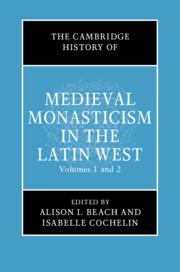Book contents
- The Cambridge History of Medieval Monasticism in the Latin WEST
- The New Cambridge History of Medieval Monasticism in the Latin West
- The Cambridge History of Medieval Monasticism in the Latin WEST
- Copyright page
- Contents
- Figures
- Contributors
- Acknowledgments
- Abbreviations
- 1 General Introduction
- Part I The Origins of Christian Monasticism to the Eighth Century
- 2 The Monastic Laboratory: Perspectives of Research in Late Antique and Early Medieval Monasticism
- 3 Re-Reading Monastic Traditions: Monks and Nuns, East and West, from the Origins to c. 750
- 4 The Archaeology of the Earliest Monasteries
- 5 Egyptian Nuns in Late Antiquity as Exemplars
- 6 Psalmody and Prayer in Early Monasticism
- 7 Heterodoxy and Monasticism around the Mediterranean Sea
- 8 The Invention of Western Monastic Literature: Texts and Communities
- 9 Monastic Rules (Fourth to Ninth Century)
- 10 Social Plurality and Monastic Diversity in Late Antique Hispania (Sixth to Eighth Century)
- 11 Female House Ascetics from the Fourth to the Twelfth Century
- 12 The Archaeology of the Earliest Monasteries in Italy and France (Second Half of the Fourth Century to the Eighth Century)
- 13 Nuns and Monks at Work: Equality or Distinction between the Sexes? A Study of Frankish Monasteries from the Sixth to the Tenth Century
- 14 Ascetic Prayer for the Dead in the Early Medieval West
- 15 Monastic Identity in Early Medieval Ireland
- 16 Constructing Monastic Space in the Early and Central Medieval West (Fifth to Twelfth Century)
- 17 The Economy of Byzantine Monasteries
- Part II The Carolingians to the Eleventh Century
- Part III The Long Twelfth Century
- Part IV Forms of Monasticism in the Late Middle Ages
- Index
- References
3 - Re-Reading Monastic Traditions: Monks and Nuns, East and West, from the Origins to c. 750
from Part I - The Origins of Christian Monasticism to the Eighth Century
Published online by Cambridge University Press: 16 January 2020
- The Cambridge History of Medieval Monasticism in the Latin WEST
- The New Cambridge History of Medieval Monasticism in the Latin West
- The Cambridge History of Medieval Monasticism in the Latin WEST
- Copyright page
- Contents
- Figures
- Contributors
- Acknowledgments
- Abbreviations
- 1 General Introduction
- Part I The Origins of Christian Monasticism to the Eighth Century
- 2 The Monastic Laboratory: Perspectives of Research in Late Antique and Early Medieval Monasticism
- 3 Re-Reading Monastic Traditions: Monks and Nuns, East and West, from the Origins to c. 750
- 4 The Archaeology of the Earliest Monasteries
- 5 Egyptian Nuns in Late Antiquity as Exemplars
- 6 Psalmody and Prayer in Early Monasticism
- 7 Heterodoxy and Monasticism around the Mediterranean Sea
- 8 The Invention of Western Monastic Literature: Texts and Communities
- 9 Monastic Rules (Fourth to Ninth Century)
- 10 Social Plurality and Monastic Diversity in Late Antique Hispania (Sixth to Eighth Century)
- 11 Female House Ascetics from the Fourth to the Twelfth Century
- 12 The Archaeology of the Earliest Monasteries in Italy and France (Second Half of the Fourth Century to the Eighth Century)
- 13 Nuns and Monks at Work: Equality or Distinction between the Sexes? A Study of Frankish Monasteries from the Sixth to the Tenth Century
- 14 Ascetic Prayer for the Dead in the Early Medieval West
- 15 Monastic Identity in Early Medieval Ireland
- 16 Constructing Monastic Space in the Early and Central Medieval West (Fifth to Twelfth Century)
- 17 The Economy of Byzantine Monasteries
- Part II The Carolingians to the Eleventh Century
- Part III The Long Twelfth Century
- Part IV Forms of Monasticism in the Late Middle Ages
- Index
- References
Summary
To present the textual sources of Western monasticism up to c. 750, it is essential to involve specialists of Eastern Christianity in order to take into account the exchanges and reciprocal influences that have shaped the monks from different regions of the Christian world. In addition to my contribution on Latin sources, Michel Kaplan was responsible for the Greek sources, Anne Boud’hors for the Coptic ones, Muriel Debié for the Syriac sources (outside Palestine), and Bénédicte Lesieur for the Palestinian ones. Nevertheless, any attempt at synthesis would be premature; if many texts have been translated—from Greek to Latin and vice versa, but also into Syriac, Coptic, Arabic, Georgian, Armenian, and Ethiopian—no existing repertory lists them. The current state of our knowledge is still lacunary, for it relies on an outmoded vision of history that separated and even opposed East and West.
- Type
- Chapter
- Information
- Publisher: Cambridge University PressPrint publication year: 2020

